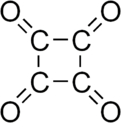- Cyclobutanetetrone
-
Cyclobutanetetrone  Cyclobutane-1,2,3,4-tetraone[citation needed]Other namesTetraoxocyclobutane
Cyclobutane-1,2,3,4-tetraone[citation needed]Other namesTetraoxocyclobutaneIdentifiers CAS number 3617-57-0 
ChemSpider 24735246 
Jmol-3D images Image 1 - O=C1C(=O)C(=O)C1=O
Properties Molecular formula C4O4 Molar mass 112.04 g mol−1 Exact mass 111.979658488 g mol-1  (verify) (what is:
(verify) (what is:  /
/ ?)
?)
Except where noted otherwise, data are given for materials in their standard state (at 25 °C, 100 kPa)Infobox references Cyclobutanetetrone, also called tetraoxocyclobutane, is a hypothetical organic compound with formula C4O4 or (-(C=O)-)4, the fourfold ketone of cyclobutane. It would be an oxide of carbon, indeed a tetramer of carbon monoxide.
The compound seems to be thermodynamically unstable.[1] As of 2000, it had yet to be synthesized in significant amounts[2][3] but may have transient existence as detected by mass spectrometry.[4]
Related compounds
Cyclobutanetetrone can be viewed as the neutral counterpart of the squarate anion C4O42−, which is stable and has been known at least since 1959.[5]
The compound octahydroxycyclobutane or cyclobutane-1,1,2,2,3,3,4,4-octaol (-C(OH)2-)4 may be referred to in the literature as "hydrated tetraoxocyclobutane".[6]
References
- ^ Haijun Jiao, Gilles Frapper, Jean-François Halet, and Jean-Yves Saillard (2001), Stability of Tetraoxocyclobutane Revised: Perturbation Theory and Density Functional Scheme. J. Phys. Chem. A, volume 105 issue 24, pp. 5945–5947. DOI: 10.1021/jp010738i
- ^ Mordecai B. Rubin and Rolf Gleiter (2000), The Chemistry of Vicinal Polycarbonyl Compounds. Chemical Reviews, volume 100 issue 3, pp. 1121–1164. DOI: 10.1021/cr960079j
- ^ Gunther Seitz; Peter Imming (1992). "Oxocarbons and pseudooxocarbons". Chemical Reviews 92 (6): 1227–1260. doi:10.1021/cr00014a004. http://admin.pubs.acs.org/doi/pdf/10.1021/cr00014a004.
- ^ Detlef Schröder,; Helmut Schwarz, Suresh Dua, Stephen J. Blanksby and John H. Bowie (May 1999). "Mass spectrometric studies of the oxocarbons CnOn (n = 3–6)". International Journal of Mass Spectrometry 188 (1–2): 17–25. doi:10.1016/S1387-3806(98)14208-2.
- ^ Cohen, Sidney; Lacher, John R.; Park, Joseph D. (1959). "Diketocyclobutanediol". J. Am. Chem. Soc. 81 (13): 3480. doi:10.1021/ja01522a083.
- ^ Skujins, S.; Delderfield, J.; Webb, G.A. (1967). "A mass spectrometric study of some monocyclic polycarbonyl compounds". Tetrahedron 24 (13): 4805–4817. doi:10.1016/S0040-4020(01)98676-4.
- G. Maahs, P. Hegenberg (2003), Syntheses and Derivatives of Squaric Acid. Angewandte Chemie Int. Ed., Volume 5 Issue 10, Pages 888–893. DOI: 10.1002/anie.196608881
See also
Oxocarbons Common oxides Exotic oxides Compounds derived from oxides Categories:- Oxocarbons
- Hypothetical chemical compounds
Wikimedia Foundation. 2010.
